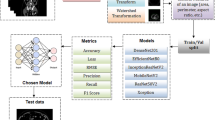Abstract
Knowing the cause of kidney stone formation is crucial to establish treatments that prevent recurrence. There are currently different approaches for determining the kidney stone type. However, the reference ex-vivo identification procedure can take up to several weeks, while an in-vivo visual recognition requires highly trained specialists. Machine learning models have been developed to provide urologists with an automated classification of kidney stones during an ureteroscopy; however, there is a general lack in terms of quality of the training data and methods. In this work, a two-step transfer learning approach is used to train the kidney stone classifier. The proposed approach transfers knowledge learned on a set of images of kidney stones acquired with a CCD camera to a final model that classifies images from endoscopic images. The results show that learning features from different domains with similar information helps to improve the performance of a model that performs classification in real conditions (for instance, uncontrolled lighting conditions and blur). Finally, in comparison to models that are trained from scratch or by initializing ImageNet weights, the obtained results suggest that the two-step approach extracts features improving the identification of kidney stones in endoscopic images.
Access this chapter
Tax calculation will be finalised at checkout
Purchases are for personal use only
Similar content being viewed by others
References
Hall, P.M.: Nephrolithiasis: treatment, causes, and prevention. Clevel. Clin. J. Med. 76(10), 583–591 (2009)
Kasidas, G.P., Samuell, C.T., Weir, T.B.: Renal stone analysis: why and how? Ann. Clin. Biochem. 41(2), 91–97 (2004)
Kartha, G., Calle, J.C., Marchini, G.S., Monga, M.: Impact of stone disease: chronic kidney disease and quality of life. Urol. Clin. 40(1), 135–147 (2013)
Scales, C.D., Smith, A.C., Hanley, J.M., Saigal, C.S., Urologic Diseases in America Project, et al.: Prevalence of kidney stones in the United States. Eur. Urol. 62(1), 160–165 (2012)
Friedlander, J.I., Antonelli, J.A., Pearle, M.S.: Diet: from food to stone. World J. Urol. 33(2), 179–185 (2014). https://doi.org/10.1007/s00345-014-1344-z
Viljoen, A., Chaudhry, R., Bycroft, J.: Renal stones. Ann. Clin. Biochem. 56(1), 15–27 (2019)
Daudon, M., Jungers, P.: Clinical value of crystalluria and quantitative morphoconstitutional analysis of urinary calculi. Nephron Physiol. 98(2), 31-p36 (2004)
Estrade, V., Daudon, M., Traxer, O., Meria, P.: Why should urologist recognize urinary stone and how? The basis of endoscopic recognition. Prog. Urol. 27(2), F26–F35 (2017)
Corrales, M., Doizi, S., Barghouthy, Y., Traxer, O., Daudon, M.: Classification of stones according to Michel Daudon: a narrative review. Eur. Urol. Focus 7(1), 13–21 (2021)
Daudon, M., et al.: Comprehensive morpho-constitutional analysis of urinary stones improves etiological diagnosis and therapeutic strategy of nephrolithiasis. C. R. Chim. 19(11–12), 1470–1491 (2016)
Keller, E.X., et al.: Fragments and dust after holmium laser lithotripsy with or without “Moses technology”: How are they different? (2019)
Estrade, V., et al.: Towards automatic recognition of pure and mixed stones using intra-operative endoscopic digital images. BJU Int. 129(2), 234–242 (2022)
Coninck De, V., Keller, E.X., Traxer, O.: Metabolic evaluation: who, when and how often. Curr. Opin. Urol. 29(1), 52–64 (2019)
Black, K.M., Law, H., Aldoukhi, A., Deng, J., Ghani, K.R.: Deep learning computer vision algorithm for detecting kidney stone composition. BJU Int. 125(6), 920–924 (2020)
Lopez, F., et al.: Assessing deep learning methods for the identification of kidney stones in endoscopic images. In: 2021 43rd Annual International Conference of the IEEE Engineering in Medicine & Biology Society (EMBC), pp. 2778–2781. IEEE (2021)
Deng, J., Dong, W., Socher, R., Li, L.-J., Li, K., Fei-Fei, L.: ImageNet: a large-scale hierarchical image database. In: 2009 IEEE Conference on Computer Vision and Pattern Recognition, pp. 248–255. IEEE (2009)
El Beze, J., et al.: Evaluation and understanding of automated urinary stone recognition methods. BJU Int. 130(6), 786–798 (2022)
Raghu, M., Zhang, C., Kleinberg, J., Bengio, S.: Transfusion: understanding transfer learning for medical imaging. In: Advances in Neural Information Processing Systems, vol. 32 (2019)
Wen, Y., et al.: On the effective transfer learning strategy for medical image analysis in deep learning. In: 2020 IEEE International Conference on Bioinformatics and Biomedicine (BIBM), pp. 827–834. IEEE (2020)
Martínez, A., et al.: Towards an automated classification method for Ureteroscopic kidney stone images using ensemble learning. In: 2020 42nd Annual International Conference of the IEEE Engineering in Medicine & Biology Society (EMBC), pp. 1936–1939. IEEE (2020)
Ochoa-Ruiz, G., et al.: On the in vivo recognition of kidney stones using machine learning. ar**v preprint ar**v:2201.08865 (2022)
Zhuang, F., et al.: A comprehensive survey on transfer learning. Proc. IEEE 109(1), 43–76 (2020)
Yosinski, J., Clune, J., Bengio, Y., Lipson, H.: How transferable are features in deep neural networks? In: Advances in Neural Information Processing Systems, vol. 27 (2014)
Mendez-Ruiz, M., Garcia, I., Gonzalez-Zapata, J., Ochoa-Ruiz, G., Mendez-Vazquez, A.: Finding significant features for few-shot learning using dimensionality reduction. In: Batyrshin, I., Gelbukh, A., Sidorov, G. (eds.) MICAI 2021. LNCS (LNAI), vol. 13067, pp. 131–142. Springer, Cham (2021). https://doi.org/10.1007/978-3-030-89817-5_10
Acknowledgments
The authors wish to acknowledge the Mexican Council for Science and Technology (CONAHCYT) for the support in terms of postgraduate scholarships in this project, and the Data Science Hub at Tecnologico de Monterrey for their support on this project. This work has been supported by Azure Sponsorship credits granted by Microsoft’s AI for Good Research Lab through the AI for Health program. The project was also supported by the French-Mexican ANUIES CONAHCYT Ecos Nord grant 322537.
Author information
Authors and Affiliations
Corresponding authors
Editor information
Editors and Affiliations
Rights and permissions
Copyright information
© 2024 The Author(s), under exclusive license to Springer Nature Switzerland AG
About this paper
Cite this paper
Lopez-Tiro, F. et al. (2024). Boosting Kidney Stone Identification in Endoscopic Images Using Two-Step Transfer Learning. In: Calvo, H., Martínez-Villaseñor, L., Ponce, H. (eds) Advances in Soft Computing. MICAI 2023. Lecture Notes in Computer Science(), vol 14392. Springer, Cham. https://doi.org/10.1007/978-3-031-47640-2_11
Download citation
DOI: https://doi.org/10.1007/978-3-031-47640-2_11
Published:
Publisher Name: Springer, Cham
Print ISBN: 978-3-031-47639-6
Online ISBN: 978-3-031-47640-2
eBook Packages: Computer ScienceComputer Science (R0)




